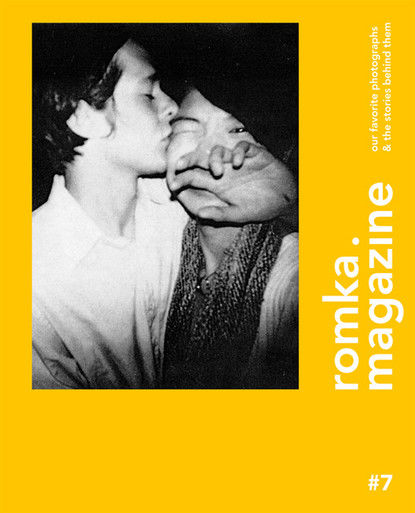Self-Portrait: Romka Magazine

23.04.2013 Features
Herbert Lechner
In this article originally published in the April issue of Novum World of Graphic Design Magazine, romka’s initiator, Joscha Bruckert tells us how this project came to life and why romka magazine belongs on paper.
A startling new phenomenon has appeared: all of a sudden, more and more magazines that have been an internet sensation are appearing in printed form. One that risked this leap relatively early was romka – of all things, a photography magazine.
“Of all things”, one may indeed say, for of course the internet has proved an ideal medium for all things photographic, and the field is correspondingly packed with presentations by young photo-designers, their collections, their self-portraits. On offer is a fascinating range of widely varying themes, styles, techniques and intentions which – granted one has sufficient time and screen size – will often lead to amazing discoveries, and has been making life hard for established print titles in this sector. That perception is shared by romka’s initiator, Joscha Bruckert, and yet it is also his very reason for choosing to go his own different way: “The whole project is built quite deliberately on the slow principle. It’s about photographs that have stood the test of time, not visual avantgarde and the latest trends. For that kind of thing, the internet is the right medium; romka belongs on paper.”
The trigger event for the project was a seminar on ‘The Market’ led by Prof. Cindy Gates during Bruckert’s photography course at FH Dortmund (Dortmund University of Applied Sciences and Arts). The students were expected to work up market-oriented projects as part of their preparation for real-life professional photography. “I was not interested in designing posters for the Savings Bank. I did want to try my hand at publishing.” The student exercise turned into the real thing. The early numbers of romka appeared in digital form: “even if it had been the right course to take at the outset, I would still never have dared to go into print at that stage.” But the response was favourable and encouraged the tyro publisher to put his original idea into practice. From Number 5 onward, romka has been coming out in printed form, annually. On sale currently is Number 7: images by 58 photographers from 21 countries on 112 pages, royal octavo, much but not all in black-and-white. Captured moments: the stories they tell mostly low-key, some very private. “For every issue there are now several hundred submissions from all over the world, mainly from photographers at the start of their careers or semi-professionals. I am particularly pleased when absolute amateurs write in, i.e. people for whom photography is genuinely just a personal hobby. My aspiration is to cover the whole range – from the amateurs to the world-renowned art photographers. The latter of course don’t contact me, but I keep on pestering them until either they tell me to get lost once and for all, or they come on board.”
The concept includes the manner of presentation and it includes the choice of paper. Where other publications work with whole-page or double-page formats printed on superb art paper, this one may include a small-format study presented all by itself on a page of recycled paper. “Every single picture is treated with respect” – that is the resolve of romka’s publisher and editor-in-chief, Bruckert, who has evidently also found the right partner for this project in the graphic artist Benedikt Bock. In practice, the deliberately reductive approach generates an unaccustomed serenity on the magazine’s pages and – together with the short captions provided by the photographers – gives the sometimes snapshot-like images an individual and very personal character. This comes out particularly clearly in the central photo sequence dealing with the theme of love, in which the pictures follow one another without captions, the commentary not being provided until pages further on. In both locations there are intentional blanks – space for one’s own memories, captured long ago in photographic images?
The magazine’s title, it may be added, itself reflects this very personal approach: Romka is the affectionate diminutive form of the Polish girl’s name Roma: an homage to a good friend of the founder-publisher. The next number is due out at the end of the year.
© 2013 Herbert Lechner
Reprinted with permission from NOVUM – World of Graphic Design, ©2013
All rights reserved. This first appeared in NOVUM – World of Graphic Design 04/13. NOVUM World of Graphic Design

relatedarticles

03.14.2022 Features
goodbye! and next steps for colleague and friend alexey lazarev

05.27.2020 Features
explorations in ethical design: meditations on equality

05.16.2017 Features
RCA launches new programme: MA Digital Direction

12.14.2016 Features
Interview | Ermolaev Bureau (Moscow)

05.11.2016 Features